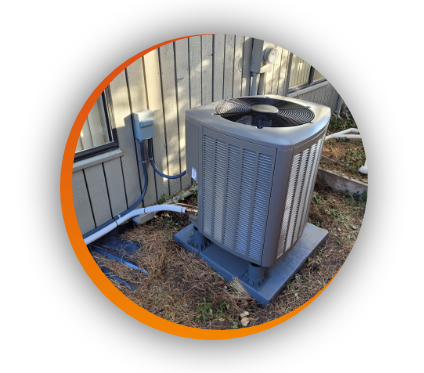Keeping your home cool during the summer is important, but there are many issues that can prevent your air conditioning from functioning effectively or stop it from working at all. A failing or blown-out AC capacitor is one such issue. The capacitor helps each of the system’s motors start, and if it fails, your AC won’t run. The good news is that the capacitor is something you can replace yourself, and here is everything you need to know to do it.
The Function of an AC Capacitor
The various parts of your air conditioning system require a huge amount of power to start up—typically far more power than the circuit can provide. The AC capacitor works by storing a powerful charge of electricity so that the AC compressor, outside fan motor and indoor blower fan motor can start up without tripping the circuit breaker. When any of the motors need to start, the capacitor releases the energy and basically jump starts the motor. Some systems have a single capacitor that powers all three motors, while others have a separate capacitor for each of the three motors.
Signs That Your Capacitor Needs Replaced
Capacitors typically fail due to normal wear and tear. Over time, the capacitor loses its ability to hold a charge and this can lead to several issues. AC capacitors can also be damaged by a major power surge.
When the capacitor starts to fail, you will usually notice it in one of three ways. A failing capacitor will often make a loud clicking noise. This is a sign that you need to replace the capacitor immediately or otherwise the motor it powers could burn out. A failing capacitor can also cause hard-starting, where the motor struggles to turn on and then immediately shuts off again. If the capacitor has fully failed, the motor won’t turn on at all and will make a humming or buzzing sound whenever it tries to start.
Steps for Removing an AC Capacitor
Replacing an AC capacitor is definitely something you can do yourself, but you need to be extremely careful when doing so. The capacitor contains a huge amount of electricity and can give you a major shock if you touch it without first dispersing the energy. This can be done by taking an insulated screwdriver and placing the blade over the two terminals. The metal blade creates a circuit between the two terminals, which discharges the stored electricity.
Before discharging the capacitor, it is essential that you shut off the power to the unit. First set the thermostat to “OFF” and then shut off the electricity to the unit. Some systems have a circuit breaker or fuse box outside near the AC compressor. The circuit breaker can be simply switched to off, but if you have a block fuse, this will need to be removed.
If there is no outside power shut-off, you will have to switch off the power to the unit by flipping the AC circuit breaker in your main electrical panel. It will be a two-handle, 240-volt breaker and it should be labeled as air conditioner. If the breaker isn’t labeled, you can either try to flip each 240-volt breaker until you find the correct one or simply shut off the main circuit breaker that controls the entire electrical system.
Once the power is off, remove the access panel near the back of the unit where the power feeds into it. You should see a metal cylinder that looks similar to a can with wires coming out of the top or bottom, and this is the capacitor. Take your insulated screwdriver and discharge the capacitor.
You’ll then need to label the wires before removing them. Each wire has to go to its specific post or else the capacitor won’t work so you need to label them so you know where each wire goes when installing the replacement part.
If you have a dual capacitor that powers the blower fan motor inside, it will have three wires—fan, compressor and common. If the capacitor only powers the compressor and outdoor fan motor, it will only have two wires. There should be markings on the capacitor that show what each wire is for. The fan wire should be labeled “F”, the common wire will be labeled “C” and the compressor wire is usually labeled “H” for hermetic. Once you’ve labeled the wires, you can disconnect them and remove the capacitor.
Take the old capacitor with you to the home improvement or hardware store to ensure you get the right part. The new capacitor will need to have the exact same specifications or else it won’t work. The three important specifications are tolerance, capacitance and load voltage. The new capacitor may be a slightly different size or not look exactly like the old one, but it will still work as long as these three specifications are the same.
Installing the New AC Capacitor
Once you have the new capacitor in hand, it’s time to get it installed. Secure the new capacitor in place using the metal mounting strap. If the old strap is damaged, you will need to get a new one. After mounting the capacitor, slide the end of each wire connector onto the post. Make sure that each wire goes to the correct post.
The new capacitor should be ready to go, but you’ll want to test to make sure it works before closing the unit back up. Switch the power back on to the system by flipping the circuit breaker or reinserting the block fuse. Next, turn your thermostat to cooling mode and set the temperature to lower than the current indoor temp so the system turns on.
If the system immediately turns on and stays on then you’re all set. If it doesn’t turn on, then most likely you didn’t connect the wires to the correct post. In this situation, you will need to shut the power off again and then check to make sure that each wire is in the correct location. Make sure to discharge the capacitor again before touching it. Even if it is not wired correctly, it will most likely still have a charge stored and could shock you if you don’t discharge it first.
If the capacitor is wired correctly and your air conditioning still won’t turn on, then you either didn’t buy the correct capacitor or the system has some other issue that is preventing it from starting. In this case, you will need to have a certified AC technician inspect the system to determine what is causing it not to start. Most likely the problem is that one of the motors is burnt out and needs to be replaced.
Expert AC Inspections and Repairs
If you suspect your AC capacitor has failed and aren’t comfortable with replacing it yourself, the certified HVAC technicians at Blue Best Plumbing, Heating, Air, Generators are here to help. We can also inspect your entire AC system to see if there are any other issues that are preventing it from starting or working as efficiently or effectively as it should. We service and repair all types of central air conditioners from any brand. If your AC compressor has died or you’re looking to upgrade to a more energy-efficient unit, we also specialize in air conditioning installation.
We have more than two decades of experience providing air conditioning and heating services to residents of Bountiful and the rest of the Greater Salt Lake City area, and we also specialize in indoor air quality services. Whether you need your AC capacitor replaced or any other HVAC service, give us a call today.








